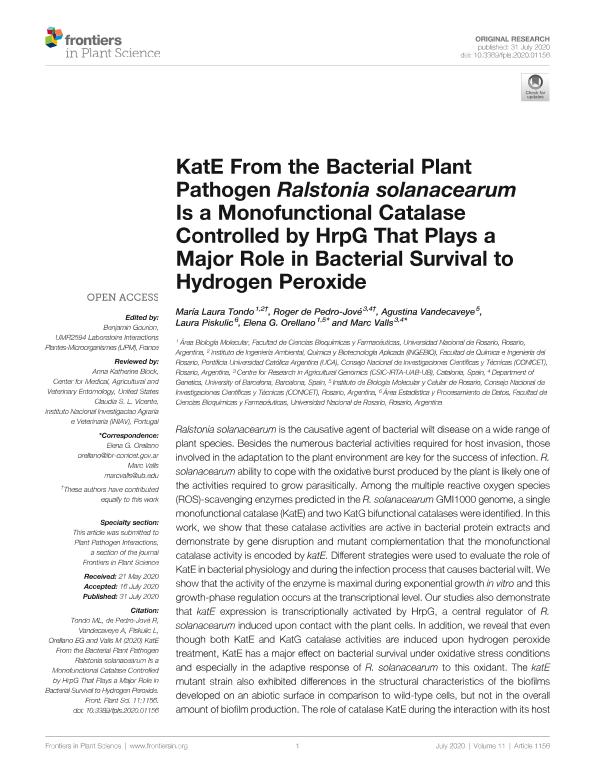Mostrar el registro sencillo del ítem
dc.contributor.author
Tondo, Maria Laura

dc.contributor.author
De Pedro Jové, Roger
dc.contributor.author
Vandecaveye, Agustina Irene

dc.contributor.author
Piskulic, Laura

dc.contributor.author
Orellano, Elena Graciela

dc.contributor.author
Valls, Marc
dc.date.available
2022-09-21T17:12:29Z
dc.date.issued
2020-07
dc.identifier.citation
Tondo, Maria Laura; De Pedro Jové, Roger; Vandecaveye, Agustina Irene; Piskulic, Laura; Orellano, Elena Graciela; et al.; KatE from the bacterial plant pathogen Ralstonia solanacearum is a monofunctional catalase controlled by HrpG that plays a major role in bacterial survival to hydrogen peroxide; Frontiers Media; Frontiers in Plant Science; 11; 7-2020; 1-12
dc.identifier.issn
1664-462X
dc.identifier.uri
http://hdl.handle.net/11336/169780
dc.description.abstract
Ralstonia solanacearum is the causative agent of bacterial wilt disease on a wide range of plant species. Besides the numerous bacterial activities required for host invasion, those involved in the adaptation to the plant environment are key for the success of infection. R. solanacearum ability to cope with the oxidative burst produced by the plant is likely one of the activities required to grow parasitically. Among the multiple reactive oxygen species (ROS)-scavenging enzymes predicted in the R. solanacearum GMI1000 genome, a single monofunctional catalase (KatE) and two KatG bifunctional catalases were identified. In this work, we show that these catalase activities are active in bacterial protein extracts and demonstrate by gene disruption and mutant complementation that the monofunctional catalase activity is encoded by katE. Different strategies were used to evaluate the role of KatE in bacterial physiology and during the infection process that causes bacterial wilt. We show that the activity of the enzyme is maximal during exponential growth in vitro and this growth-phase regulation occurs at the transcriptional level. Our studies also demonstrate that katE expression is transcriptionally activated by HrpG, a central regulator of R. solanacearum induced upon contact with the plant cells. In addition, we reveal that even though both KatE and KatG catalase activities are induced upon hydrogen peroxide treatment, KatE has a major effect on bacterial survival under oxidative stress conditions and especially in the adaptive response of R. solanacearum to this oxidant. The katE mutant strain also exhibited differences in the structural characteristics of the biofilms developed on an abiotic surface in comparison to wild-type cells, but not in the overall amount of biofilm production. The role of catalase KatE during the interaction with its host plant tomato is also studied, revealing that disruption of this gene has no effect on R. solanacearum virulence or bacterial growth in leave tissues, which suggests a minor role for this catalase in bacterial fitness in planta. Our work provides the first characterization of the R. solanacearum catalases and identifies KatE as a bona fide monofunctional catalase with an important role in bacterial protection against oxidative stress.
dc.format
application/pdf
dc.language.iso
eng
dc.publisher
Frontiers Media

dc.rights
info:eu-repo/semantics/openAccess
dc.rights.uri
https://creativecommons.org/licenses/by/2.5/ar/
dc.subject
BACTERIAL WILT
dc.subject
HOST ADAPTATION
dc.subject
KATE CATALASE
dc.subject
OXIDATIVE BURST
dc.subject
RALSTONIA SOLANACEARUM
dc.subject.classification
Bioquímica y Biología Molecular

dc.subject.classification
Ciencias Biológicas

dc.subject.classification
CIENCIAS NATURALES Y EXACTAS

dc.title
KatE from the bacterial plant pathogen Ralstonia solanacearum is a monofunctional catalase controlled by HrpG that plays a major role in bacterial survival to hydrogen peroxide
dc.type
info:eu-repo/semantics/article
dc.type
info:ar-repo/semantics/artículo
dc.type
info:eu-repo/semantics/publishedVersion
dc.date.updated
2022-09-19T20:38:17Z
dc.identifier.eissn
1664-462X
dc.journal.volume
11
dc.journal.pagination
1-12
dc.journal.pais
Suiza

dc.description.fil
Fil: Tondo, Maria Laura. Universidad Nacional de Rosario; Argentina. Pontificia Universidad Católica Argentina "Santa María de los Buenos Aires"; Argentina. Consejo Nacional de Investigaciones Científicas y Técnicas; Argentina
dc.description.fil
Fil: De Pedro Jové, Roger. Universidad de Barcelona; España
dc.description.fil
Fil: Vandecaveye, Agustina Irene. Consejo Nacional de Investigaciones Científicas y Técnicas. Centro Científico Tecnológico Conicet - Rosario. Instituto de Biología Molecular y Celular de Rosario. Universidad Nacional de Rosario. Facultad de Ciencias Bioquímicas y Farmacéuticas. Instituto de Biología Molecular y Celular de Rosario; Argentina
dc.description.fil
Fil: Piskulic, Laura. Universidad Nacional de Rosario. Facultad de Ciencias Bioquímicas y Farmacéuticas; Argentina
dc.description.fil
Fil: Orellano, Elena Graciela. Consejo Nacional de Investigaciones Científicas y Técnicas. Centro Científico Tecnológico Conicet - Rosario. Instituto de Biología Molecular y Celular de Rosario. Universidad Nacional de Rosario. Facultad de Ciencias Bioquímicas y Farmacéuticas. Instituto de Biología Molecular y Celular de Rosario; Argentina
dc.description.fil
Fil: Valls, Marc. Universidad de Barcelona; España
dc.journal.title
Frontiers in Plant Science
dc.relation.alternativeid
info:eu-repo/semantics/altIdentifier/doi/http://dx.doi.org/10.3389/fpls.2020.01156
dc.relation.alternativeid
info:eu-repo/semantics/altIdentifier/url/https://www.frontiersin.org/articles/10.3389/fpls.2020.01156/full
Archivos asociados
